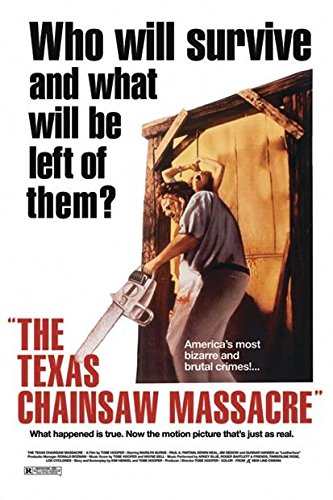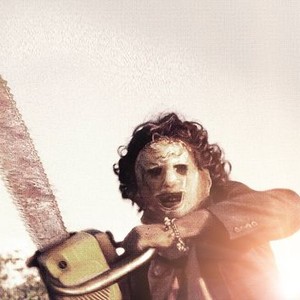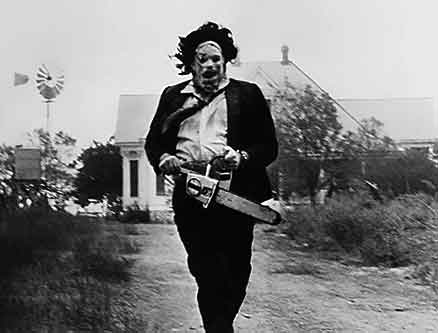 Truthfully, not a whole lot remains to be written about THE TEXAS CHAINSAW MASSACRE, certainly one of the most iconic genre films of all time. I’ll say my peace, though, as I, like quite a few other commentators, feel it’s a deserved classic.
Truthfully, not a whole lot remains to be written about THE TEXAS CHAINSAW MASSACRE, certainly one of the most iconic genre films of all time. I’ll say my peace, though, as I, like quite a few other commentators, feel it’s a deserved classic.
…a deserved classic.
The most surprising thing about this 1974 film, a favorite of gore hounds the world over, is that it isn’t very gory. Believe it or not, director Tobe Hooper was hoping for a PG rating. He ended up with an R, of course, and made history with one of the most brutally intense films of all time.
Initially titled LEATHERFACE, the film was lensed on location in South Texas under horrendous conditions. The delirious climax was shot over a torturous 30 hours, in a sweltering house stuffed with rotting animal flesh, with cast and crew members allowed outside only for brief stretches (to vomit). Those conditions contributed immeasurably to the madness and ugliness of the finished film.
Believe it or not, director Tobe Hooper was hoping for a PG rating.
Unfortunately Tobe Hooper’s post-CHAINSAW output has been erratic at best. His immediate follow-ups EATEN ALIVE! and THE FUNHOUSE weren’t much. POLTERGEIST may have been Hooper’s biggest moneymaker, but it also did his reputation irreparable damage due to allegations that its producer Steven Spielberg directed most of the film himself. LIFEFORCE and INVADERS FROM MARS did little to restore Hooper’s declining stock, and nor did THE TEXAS CHAINSAW MASSACRE 2, although it wasn’t all bad. From there Hooper’s career continued along the same uninspiring path, with bummers like THE MANGLER and THE TOOLBOX MURDERS doing nothing to help matters—and no, the 2003 Michael Bay produced TCM remake didn’t either!
It begins with some young people are driving through East Texas in a van. There have been several killings in the area that have the residents on edge.
The kids pay no heed to the reports of killings, at least until they pick up a freaky hitchhiker outside a slaughterhouse. The hitchhiker claims to be an employee of the slaughterhouse, and talks graphically of some of the more unsavory killing methods practiced there. He also slashes his hand, sets fire to a handful of gunpowder and, worst of all, demands two bucks for a crummy picture he takes of the gang. They pull over to let him out—and as a parting gift the hitchhiker slashes the hand of the wheelchair-bound Franklin.
The van runs out of gas a little further down the road. Kirk, the driver, heads for an old house in search of gas—and is bashed over the head with a mallet wielded by a freaky dude wearing a human skin mask.
Unfortunately Tobe Hooper’s post-CHAINSAW output has been erratic at best.
Kirk’s girlfriend Pam comes in after him. Grabbed by “Leatherface,” she’s killed by having a sharp hook stuck through her back. Next to enter is Jerry, who also falls victim to Leatherface and his deadly mallet.
This leaves Franklin and his sister Sally. As the sun sets and none of their friends return, they have no choice but to head for the old house themselves. But Leatherface gets them on the way, making fast work of Franklin with a noisy chainsaw. Sally manages to get away, precipitating a lengthy chase that ends with her shut up in Leatherface’s house with his ghoulish family members, whose ranks include an old man who runs a nearby gas station, an ancient crone and the hitchhiker we met earlier. The atmosphere in the place, which is packed with furniture and sculptures made from human skin and bones, is psychotic in the extreme, and only grows more so.
The bone sculptures and skin lampshades that decorate Leatherface’s residence are virtually without parallel in modern cinema.
This film may be relatively bloodless, but that doesn’t mean it’s in any way subtle or restrained. Tobe Hooper was clearly striving for a grueling and unrelenting experience that puts viewers squarely in the driver’s seat. This means an all-inclusive horrorfest that gleefully rubs our noses in its sordid universe of decaying flesh, soaring temperatures, and, in the unforgettably delirious climax, bulging eyeballs rendered in lurid close-ups. While the camerawork and editing aren’t always up to snuff (Hooper tends to favor multiple set ups that don’t always cut together harmoniously), the low budget energy of the project carries one along. This is particularly true of the final scenes, which contain some of most potent examples of pure insanity ever put on film.
This is particularly true of the final scenes, which contain some of most potent examples of pure insanity ever put on film.
Special mention must be made of the production design by Robert Burns. The bone sculptures and skin lampshades that decorate Leatherface’s residence are virtually without parallel in modern cinema. So is the overall atmosphere of ghoulish dementia, which after three sequels, a remake and countless imitations remains a unique and unforgettable component of the original and still-definitive TEXAS CHAINSAW MASSACRE.
Vital Statistics
THE TEXAS CHAINSAW MASSACRE
Vortex
Director: Tobe Hooper
Producer: Tobe Hooper, Lous Peraino
Screenplay: Kim Henkel, Tobe Hooper
Cinematography: Daniel Pearl
Editing: Larry Carroll, Sallye Richardson
Cast: Gunnar Hanson, Marilyn Burns, Allen Danziger, Paul A. Partain, William Vail, Teri McMinn, Edwin Neal, Jim Siedow, John Dugan, John Larroquette


